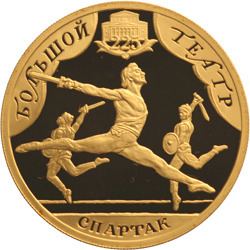Original ballet company Kirov Ballet | ||
 | ||
Premiere 1956 (1956)Kirov Theatre, Leningrad Characters CrassusSpartacusPhrygiaAegina | ||
Spartacus (Russian: «Спартак», Spartak) is a ballet by Aram Khachaturian (1903–1978). The work follows the exploits of Spartacus, the leader of the slave uprising against the Romans known as the Third Servile War, although the ballet's storyline takes considerable liberties with the historical record. Khachaturian composed Spartacus in 1954, and was awarded a Lenin Prize for the composition that same year. It was first staged, with choreography by Leonid Yakobson, in Leningrad 1956, but only with qualified success since Yakobson abandoned conventional pointe in his choreography. The ballet received its first staging at the Bolshoi Theatre, Moscow in 1958, choreographed by Igor Moiseyev; however it was the 1968 production, choreographed by Yury Grigorovich, which achieved the greatest acclaim for the ballet. It remains one of Khachaturian's best known works and is prominent within the repertoires of the Bolshoi Theatre and other ballet companies in Russia and the former Soviet Union.
Contents
Synopsis
Principal Characters:
Act I
The Roman consul Crassus returns to Rome from his latest conquests in a triumphal procession. Among his captives are the Thracian king Spartacus and his wife Phrygia. Spartacus laments his captivity and bids a bitter farewell to Phrygia, who is taken off to join Crassus’ harem of concubines. To entertain Crassus and his entourage, Spartacus is sent into the gladiatorial ring and is forced to kill a close friend. Horrified at his deed, Spartacus incites his fellow captives to rebellion.
Act II
The escaped captives celebrate their freedom. Meanwhile, Crassus entertains the Roman patricians with a lavish entertainment, including fights between blindfolded gladiators, one of whom is Spartacus. Spartacus unknowingly kills his friend in the arena. This induces Spartacus and his men to rebel. They disrupt the orgy and rescue the slave women, including Phrygia. Aegina insists that Crassus pursue the slave army immediately. The lovers celebrate their escape to the "Adagio of Spartacus and Phrygia".
Act III
Aegina discovers Spartacus’s camp and observes the lovers emerging from their tent the next morning. Aegina sends word to Crassus, who sends his army in pursuit. Internecine struggles break out among Spartacus’s forces. Finally, Crassus’s forces discover Spartacus and impale him upon their spears. Spartacus’s closest followers recover his body and carry it off while Phrygia mourns her loss.
Orchestral adaptation
Khachaturian extracted and arranged music from the ballet in 1955 for four orchestral suites:
2 flutes, 2 oboes, 2 clarinets, 2 bassoons; 4 horns, 4 trumpets, 3 trombones, tuba; timpani, percussion ; strings.
